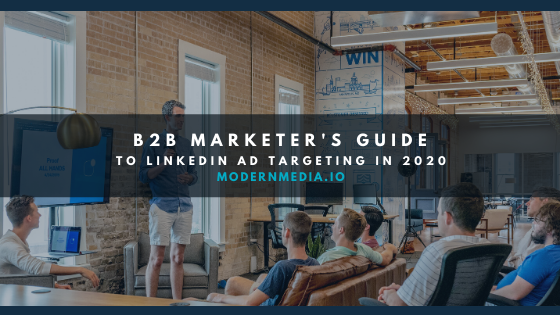If you want to grow your business, reaching decision-makers is the name of the game. And there’s no better way to reach decision-makers at B2B companies than LinkedIn.
With over 645 million members, LinkedIn is the largest community of professionals worldwide. Taking your outreach efforts to LinkedIn enables you to reach more than 61 million decision makers, including over 10 million thought leaders and 6 million C-level executives.
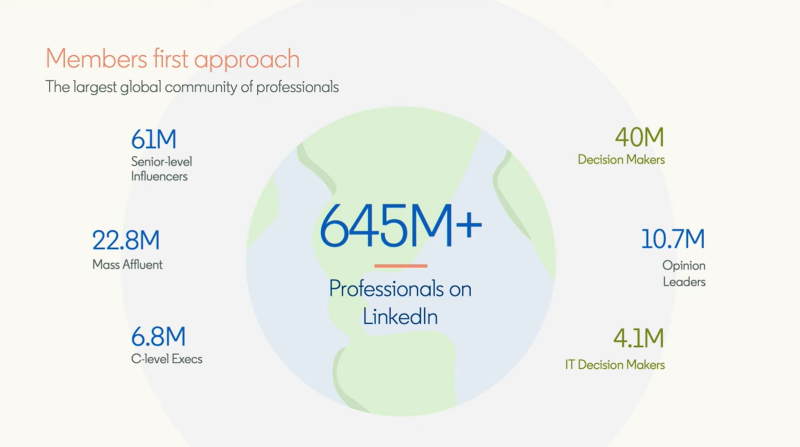
And the best part? LinkedIn members aren’t just influencers. On average, they carry twice the buying power of the typical online audience.
Successful targeting is critical for getting your ads in front of the right prospects. Effective LinkedIn campaigns are carefully targeted, reaching out to members with messages specifically crafted for them.
If you want to create targeted LinkedIn ads that convert, this is the guide for you.
Let’s get started.
How Targeting Works
In 2019, targeted advertising is a way of life. Whenever scroll through your Facebook feed, do a Google search, or check Twitter, you’ll notice ads geared to your specific interests.
It’s no different on LinkedIn. Targeted ads are a natural way to reach prospects who are most likely to buy — and LinkedIn makes it easy to create them.
LinkedIn is also a bustling hub for B2B lead generation. Over 94% of B2B marketers use LinkedIn as one of their distribution channels, and it accounts for more than 80% of all social media B2B leads. If you’re not marketing your brand on LinkedIn, you’re missing out.
On LinkedIn, members naturally want to keep their profiles up to date for professional purposes. After all, your best prospects don’t want to miss out on a great job opportunity because their profile is a year out of date. That makes it easy for you to target members based on quality, up-to-date profile-based information.
Here’s how.
Get more leads on LinkedIn in 2021.
Set up a call to get help with your LinkedIn targeting today!Creating a Targeted Ad
First things first. Sign into the Campaign Manager, click Create Campaign and give your campaign a name.
Define Your Goal and Audience
With its recent update, LinkedIn’s advertising platform — the Campaign Manager — now enables marketers to build campaigns around specific marketing objectives.
Start by choosing the goal for your campaign. If you’re interested in growing your business, you’ll probably want to set lead generation as your goal.
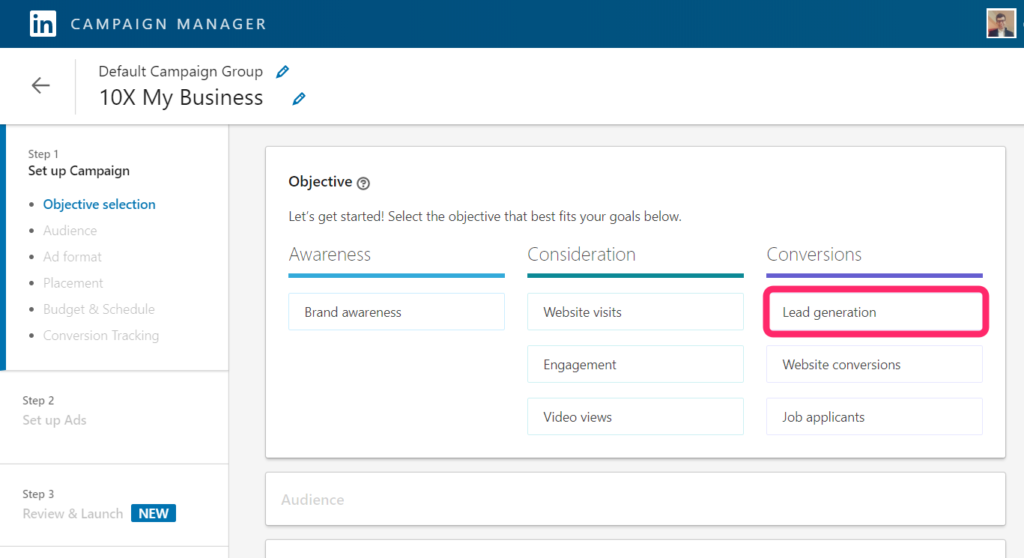
Once you’ve set your objective, choose the targeting parameters you’ll use to narrow in on your audience.
LinkedIn uses the data from a member’s profile to target individual members, including the member’s job title, their company, the school they attended, and their graduation year. You’ll start by choosing your audience’s location and their profile language.
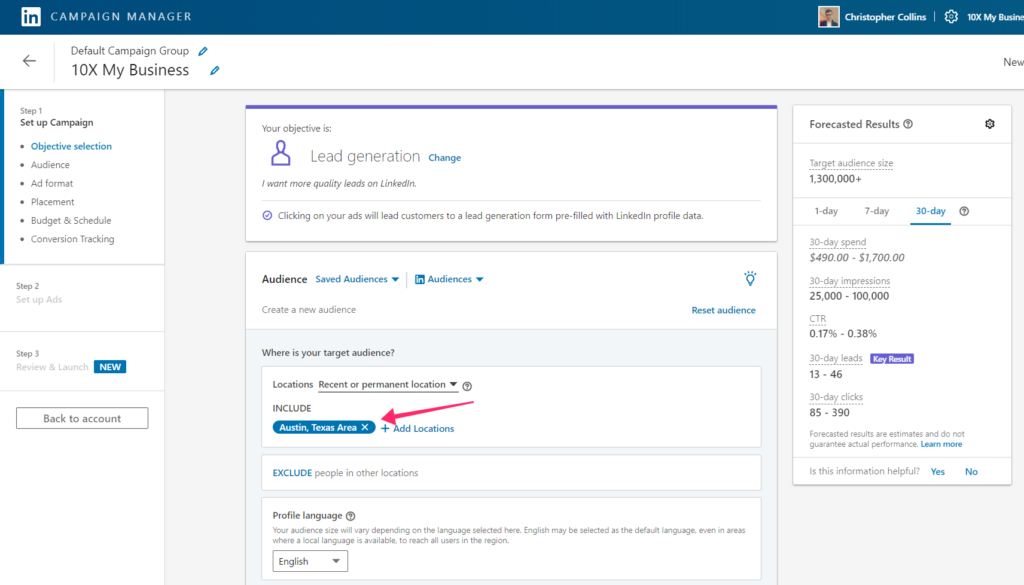
Add more conditions to narrow in on your audience. The audience count shows the number of members who fit the targeting conditions you’ve selected. Consider whether you want to target a highly specific niche or reach a wider group.
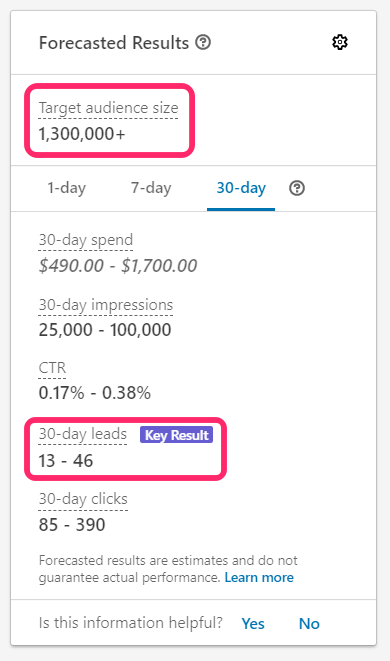
LinkedIn’s absolute minimum is 300, enabling you to go narrow. But go too narrow, you might miss out on valuable prospects who could turn into terrific clients. And you’ll be bidding against other businesses to reach a small audience… which can quickly drive your ad spend up.
Casting a wider net can enable you to reach more people who might be interested in what you have to offer. We’ve found that 20,000 to 80,000 members is usually the sweet spot for most businesses — but you’ll define the audience based on what your business needs.
Once your parameters are set, uncheck audience expansion. This enables you to specifically target your audience without adding in users LinkedIn considers to be similar.

Run a test search in LinkedIn Sales Navigator. If the users it returns are people you want to get your ad in front of, you know your targeting is on point. You can keep moving forward.
Decide on Your Campaign Budget
At this point, you can decide on your ad format and set a budget for your campaign.
LinkedIn determines the cost for online ad space using an auction system where you’ll bid against other advertisers for placement. More competition to reach your audience means you’ll pay more for your ad placement. We’ve laid out all the details in our explainer on LinkedIn ad pricing.
Hit “Save as a Template” after you’ve defined your audience… that way, you won’t ever lose your work. By saving your audience, you can use the audience you created as a template for future campaigns later on.
LinkedIn’s Targeting Options
LinkedIn offers 17 demographic categories you can use to fine-tune your target audience. Each category can be used to narrow in your ideal prospects or specify members you want to exclude.
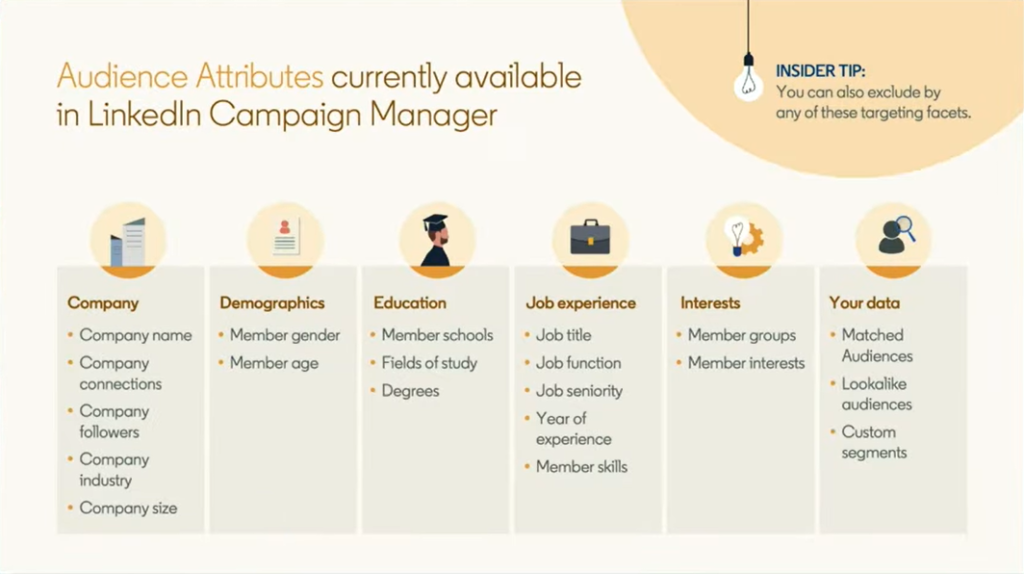
Location
Location is the only required audience parameter — and the first that you’ll specify when you set up your campaign. You can specify location at a very granular level, down to state and city. LinkedIn determines a member’s location based on their IP address.
Location-based targeting is perfect if you’re going after businesses in a specific geographic area. Here’s how we’ve used location-targeting to reach business owners. You can narrow down your location to focus on specific areas.
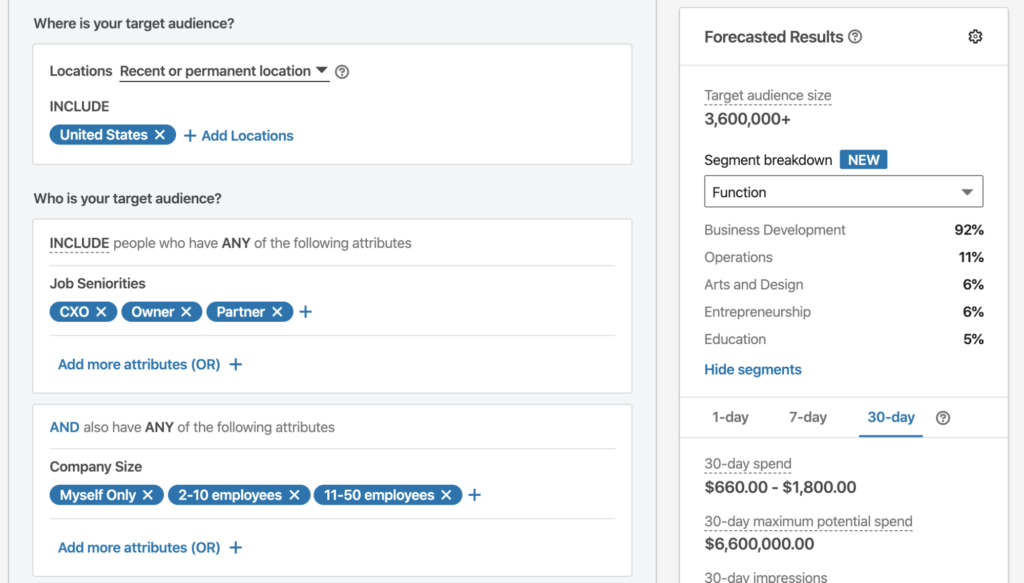
Language
When you set up your campaign, you’ll also specify the language of the members you want to reach. LinkedIn determines the language of members based on the language used in their profile. Obviously, make sure your ads are written in the language you choose.
Job Title
The simplest way to reach people in the right professional role is to target based on job title. And targeting based on just a couple of job titles is an easy mistake to make. After all, you could be failing to reach thousands of professionals in related roles who might be interested in your offer.
Fortunately, Campaign Manager has your back. When you type in a job title, Campaign Manager will autosuggest lots of other related job titles you may want to add to your campaign.
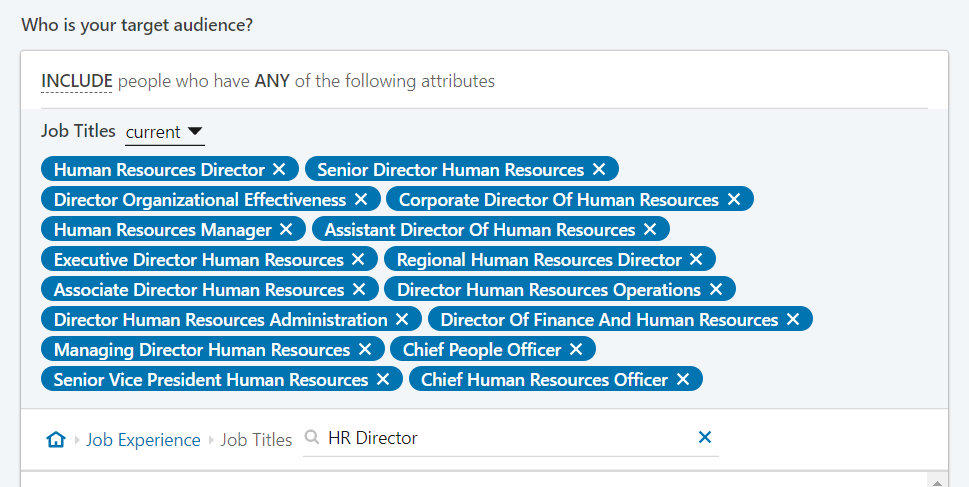
Adding more relevant titles will ensure your ad gets wider exposure. You can also widen your reach by showing your ad to past holders of relevant job titles.
Job Function
While job titles describe a person’s specific job role, job functions are broad grouping of related job titles, like “medical” or “marketing.” Targeting by job function is a great way to increase your campaign’s performance.
LinkedIn’s studies have found that targeting based on job function instead of job title can result in increased impressions and a higher click-through rate.
Job functions are an easy way to reach a broad class of members, especially when combined with other options. For instance, combining job function with seniority is a great way to target decision-makers at the Director, VP, or C-Suite level.
And job functions offer a great strategy for lowering your ad spend, since each function contains people with less common job titles who are great prospects but are typically bid on less.
Seniority
LinkedIn classifies members at ten levels of seniority:
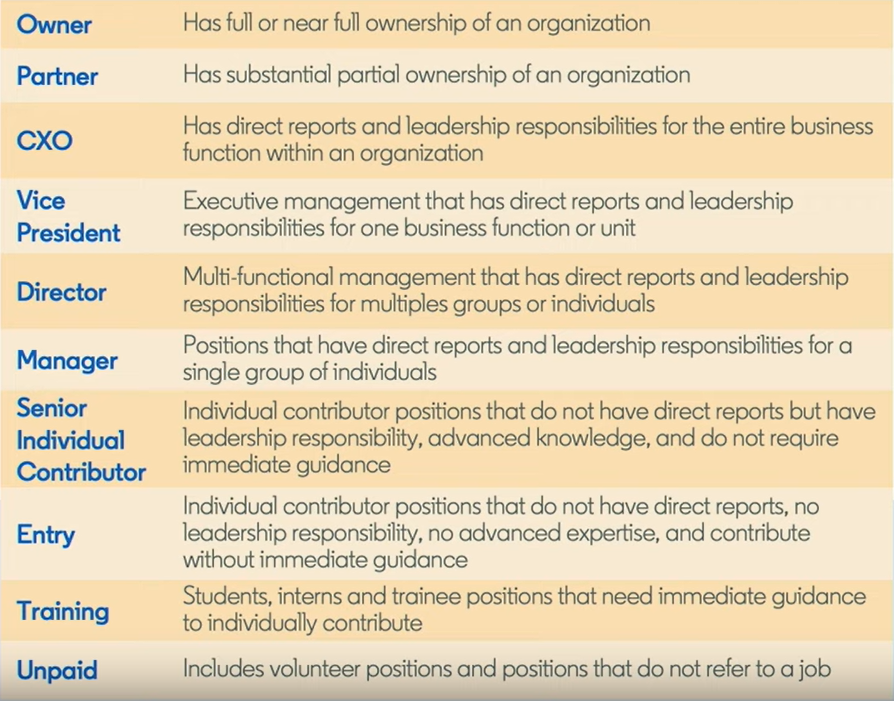
Seniority tells you about a member’s rank within their current organization. LinkedIn determines a member’s seniority based on their job title. Job titles that imply leadership over units, direct reports, or important projects are assigned greater levels of seniority.
Seniority is especially useful when layered with other categories, like job function. Here’s how we’ve combined seniority with job function to reach high-level IT decision makers:
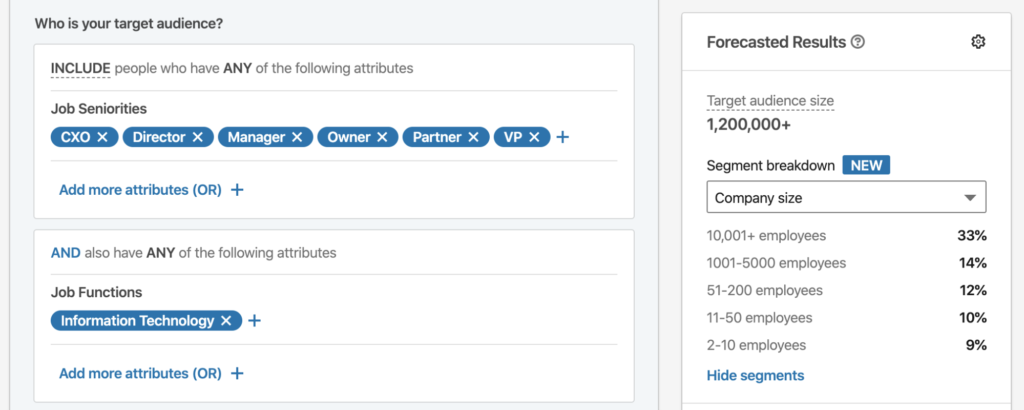
Be careful with seniority. Job titles with lower seniority aren’t necessarily lower-level employees. For example, consider an IT specialist with no direct reports who has 15 years of experience. Since this employee has no leadership responsibility, he would be considered entry level.
Increasingly, targeting senior individual contributors is an effective way to influence decision-makers. Contributors at this level are valued for their years of experience and often have significant say in buying decisions. Consider targeting senior ICs in your next campaign.
Years of Experience
Years of experience (YOE) enables you to target an audience based on the years of professional experience they’ve racked up over the course of their career. Like job function, years of experience is especially powerful when used in combination with other targeting parameters.
Years of experience is especially powerful when paired with job function or seniority.
- Pairing YOE with job functions enables you to reach veteran leaders who’ve accumulated years of expertise in their field.
- Combining YOE with high levels of seniority — such as Director and above — enables you to contact experienced decision-makers with influence over buying decisions in their organizations.
Company Name
Company name targeting is straightforward — it enables you to target decision-makers at specific organizations. You can reach up to 100 organizations.
Need more? With Matched Audiences, you can use Account Targeting to go after decision-makers at up to 300,000 companies. (More on this below.)
Company Industry
Company industry lets you target members who work in a specific industry. Targeting based on industry is a great strategy if you have an offer that’s sure to appeal to members across a broad sector.
Company industry is an ideal approach for reaching ecommerce stores based on the types of products they focus on. Layered with skills targeting, you can also reach members with specific skills:
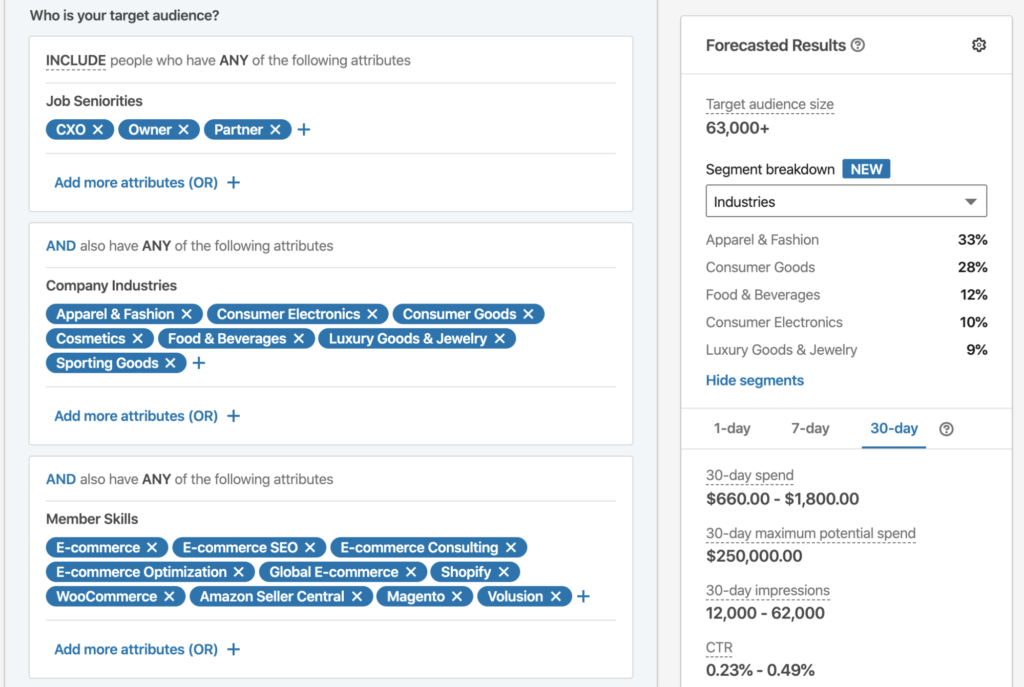
Word to the wise: company industry is based on the primary industry in which a company operates. If a company works across multiple industries, LinkedIn will only list the main industry of operation on their LinkedIn page.
Before you target by company industry, check out a few LinkedIn pages for companies you’d consider to be within your sector. Consider including any relevant industries you see to make sure your targeting is on track.
Company Size
Company size is an easy way to make sure you’re targeting only companies that are the ideal size to become future clients. Only want to work with small companies? Exclude members whose workplace has a company size of 500 or more from your targeting.
LinkedIn groups companies into nine tiers based on company size.
- Myself Only
- 2-10 employees
- 11-50
- 51-200
- 201-500
- 501-1000
- 1001-5000
- 5000-10,000
- 10,001+
Company size is ideal when you combine it with job function. For example, here’s how we’ve layered company size and job function to reach corporate HR managers:
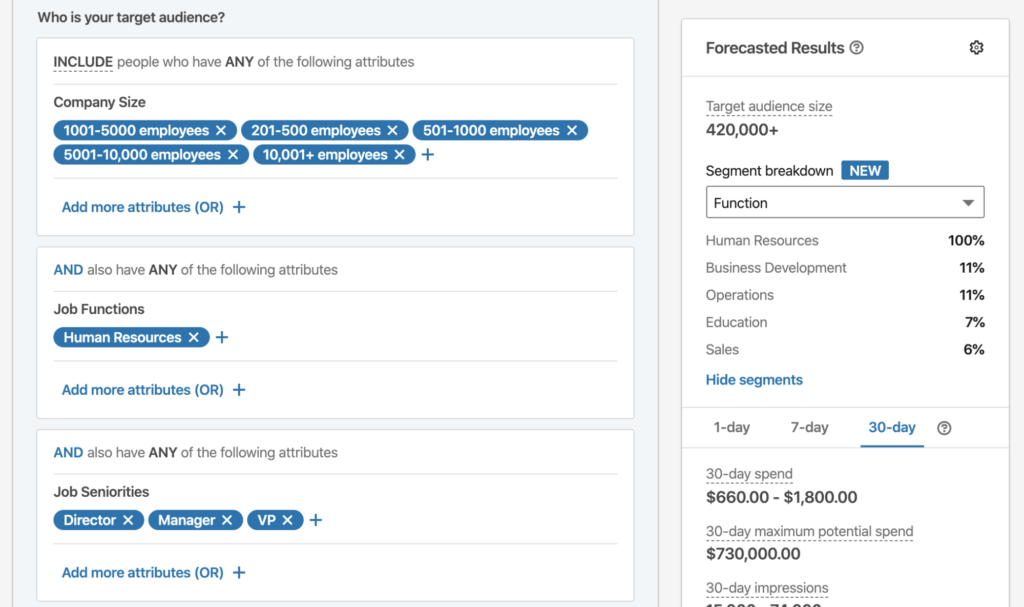
Groups
LinkedIn members often join groups with other members who share common interests and professional connections. Membership in relevant groups can indicate experience in a particular field. It’s a great way to reach members who are highly knowledgeable in a specific area.
Skills
Sometimes, job title or job function targeting might not be effective in reaching a very niche audience you want. When that happens, skills targeting is exactly what you need.
While you can explicitly list your skills, LinkedIn can also infer your skills based on the keywords found throughout your profile. Skills targeting is a great way to reach members with highly specific capabilities in a particular area. Take a look at how we’ve used skills targeting to reach developers based on their specialization:
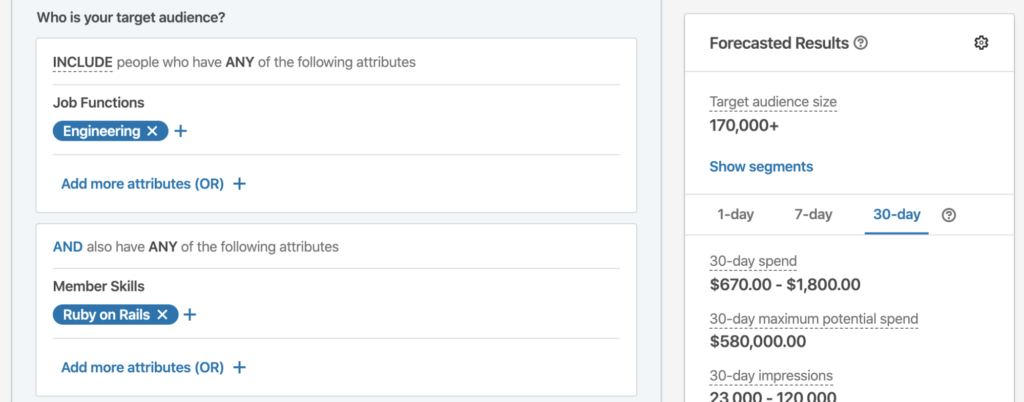
If you’re using skills targeting, consider using the job function or seniority categories to fine-tune your search and reach relevant prospects.
For example, if you want to reach people who work in HR with training experience, you could combine the HR function with skills in training. If you want to reach senior decision-makers in HR, you can target your ad at members working in HR at the Director level or above.
Interests
Interest-based targeting is a brand new LinkedIn feature that made its debut in the summer of 2019. Most other LinkedIn targeting is based on the information a member enters in their profile — but interest-based targeting is based on a member’s activity on the platform.
As a member demonstrates interest in specific topics through their interactions with content on the platform, LinkedIn gathers information on the topics they’re interested in.
Like skills targeting, interest targeting works especially well when paired with the job function or seniority categories. For example, if you want to reach senior-level decision makers with an interest in project management, consider targeting members interested in project management at the Director level and above.
Exercise Caution: School, Age, and Gender
While most categories can help you narrow in on your target audience, three categories will drastically reduce the reach of your ad if used carelessly. Let’s take a closer look.
School
If you like, you can target members by the specific school, college, or university they attended. Be sure to add subsidiary schools you want to include, since each has its own separate page on LinkedIn — for instance, not just UVa, but also UVa Law.
Using school can actually decrease your audience size — more than you’d expect. Members aren’t required to enter their educational history when creating a LinkedIn profile, so you may end up missing many active members who attended the school you’re targeting. In general, avoid targeting by school unless you truly need to reach members who attended a particular institution.
Age
LinkedIn estimates a member’s age based on their first graduation date. Targeting based on age can often reduce your audience size significantly — and in most cases, it’s not necessary to target your ad effectively.
In most cases, targeting based seniority or years of experience will yield significantly wider exposure for your ad. LinkedIn found that when targeting executives, targeting by age results in a 70% smaller audience than targeting by seniority. Similarly, when targeting high-tech career starters, targeting by age instead of seniority diminished audience size by 91%.
Gender
Just like with age, LinkedIn doesn’t ask members for gender on their profile but rather infers it based on a member’s name. Targeting based on gender isn’t recommended unless you have an offer that’s highly relevant to a specific gender. After all, gender-based targeting will cut your audience size in half.
Raise your LinkedIn lead gen game in 2021.
Set up a call to get help with your LinkedIn targeting today!Advanced Targeting Techniques
LinkedIn’s audience targeting criteria are just the start. With LinkedIn’s Matched Audiences, you’ll find a range of advanced tools to help you pinpoint the exact audience you want to reach.
Let’s take a closer look.
Account Targeting
If you’re using Account-Based Marketing (ABM), LinkedIn’s Account Targeting feature is perfect for you. With ABM, you concentrate your sales and marketing strategy on a small, clearly defined set of target accounts instead of casting a much wider net.
The upshot for your company? Greater personalization, more optimized campaigns and a higher ROI for your ad spend.
LinkedIn’s Account Targeting feature is an ideal tool for reaching employees at the specific companies in your target market. With Account Targeting, you can identify up to 300,000 companies that you want to target specifically. LinkedIn will check your list against its member database and show your ad only to users who are employed by one of those companies.
To use Account Targeting, you’ll need to set up a Matched Audience. Under “Who Is My Target Audience?” choose Matched Audiences, and then select the Upload Lists option.
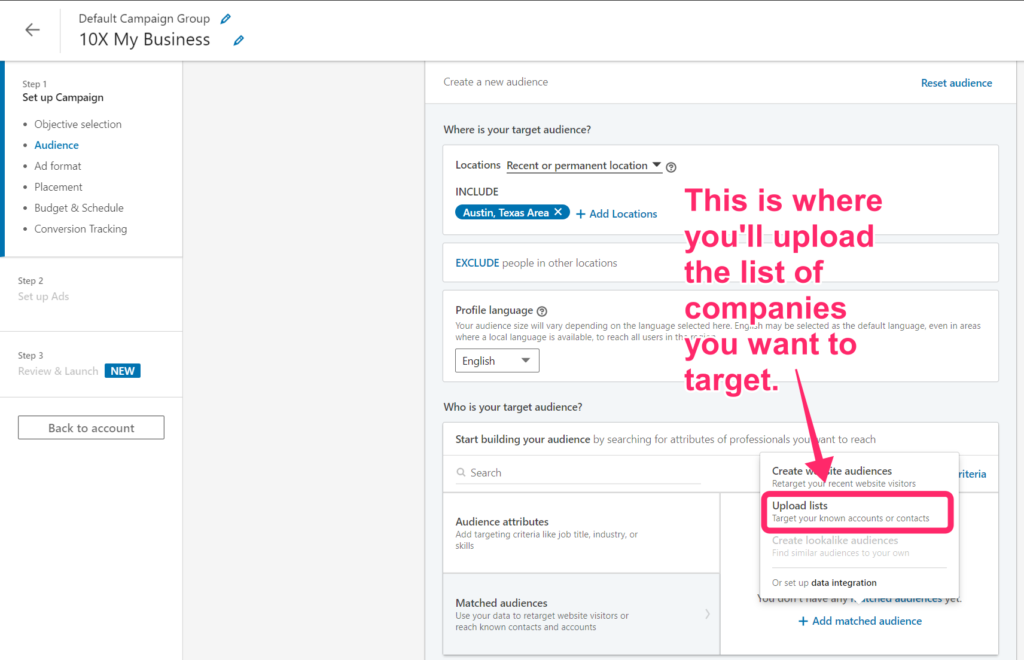
Download the account list template provided and fill in your target companies, then upload the account list to LinkedIn.
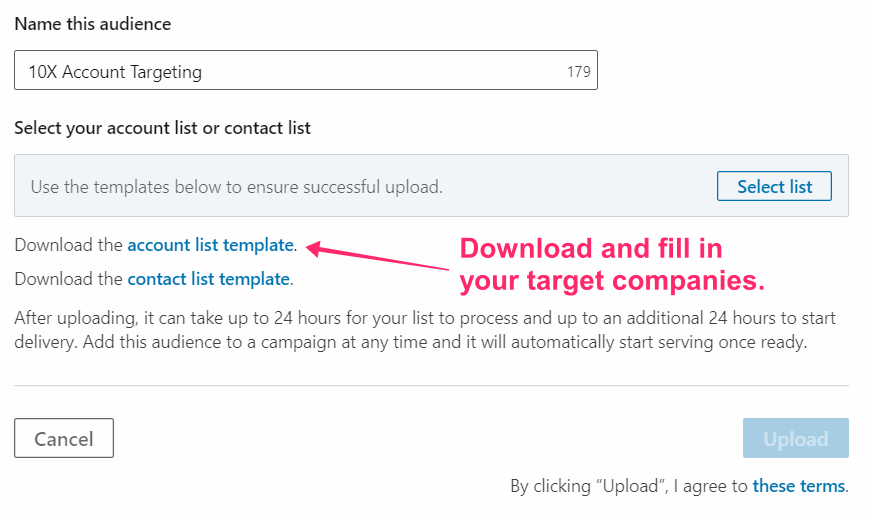
Pro tip: Check each company’s LinkedIn page to make sure the name in your account list matches exactly. You won’t reach anyone at that company if the name in your account list isn’t an exact match.
You might think setting up your list will be easy, but creating a list of relevant companies that meets LinkedIn’s minimum of 300 companies can be a very demanding project.
You’ll want to have someone on your team research relevant companies on the Internet. Sites like Business.com, Jayde, and Manta are good places to start.
Contact Targeting
Contact Targeting is the perfect way to pinpoint your target audience on LinkedIn. You can deliver customized ads to LinkedIn members on your email list, tailored to their stage in the sales funnel. All you need is your existing email list.
Just like with Account Targeting, you’ll need to set up a Matched Audience to use Contact Targeting. Download the contact list template and fill in your list of contacts, then upload it to LinkedIn:
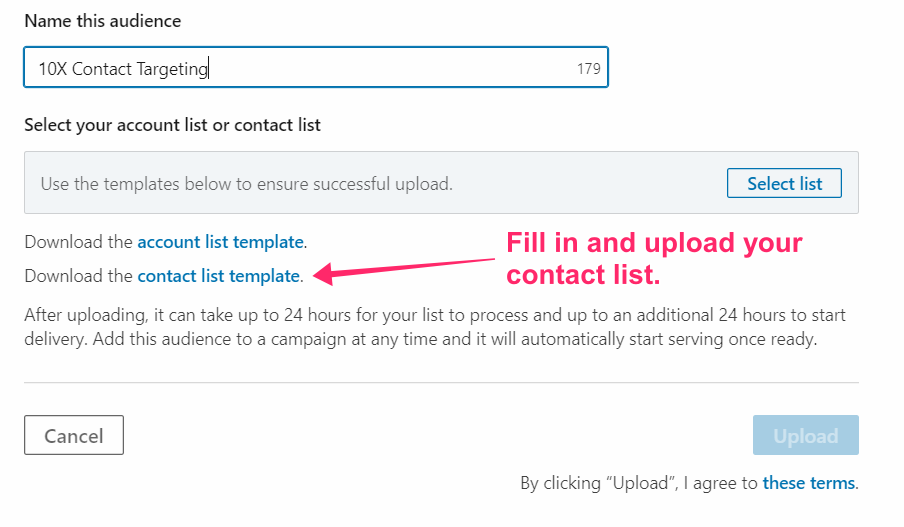
Just like with Account Targeting, you’ll need a list of at least 300 contacts to use Contact Targeting. Contact Targeting and Account Targeting typically takes about 24 hours to process, with larger lists taking longer. LinkedIn recommends that you allow a 48 hour window as a best practice.
LinkedIn’s Contact Targeting function also integrates with most of the major CRM systems, including Salesforce, Marketo, Liveramp, and Hubspot. You can use these integrations to keep your contact list automatically updated in LinkedIn… and avoid the hassle of repeated manual uploads.
Once you’ve made contact, sharing content with new leads can help you build your authority and guide your contacts down the funnel. You can also use contacts as exclusions. For example, if you’ve closed an account or determined that a lead is a no go, you can exclude them from further communication.
Website Retargeting
Retargeting your ads is one of the most powerful ways to make sure they convert. Retargeted get a click-through rate up to 10X higher than ads that aren’t and yield up to a 70% lift in conversions.
LinkedIn uses a free, lightweight tag called the LinkedIn Insights Tag to track which members visit your website. To get started, go to the Campaign Manager and choose “Insight Tag” from the Account Assets menu.
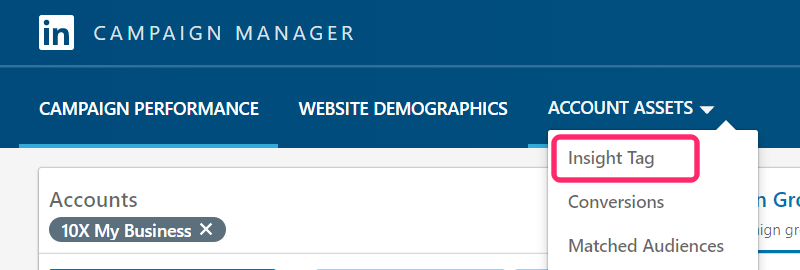
Choose “I Will Install The Tag Myself” to get the code snippet, or install it using one of the other options.
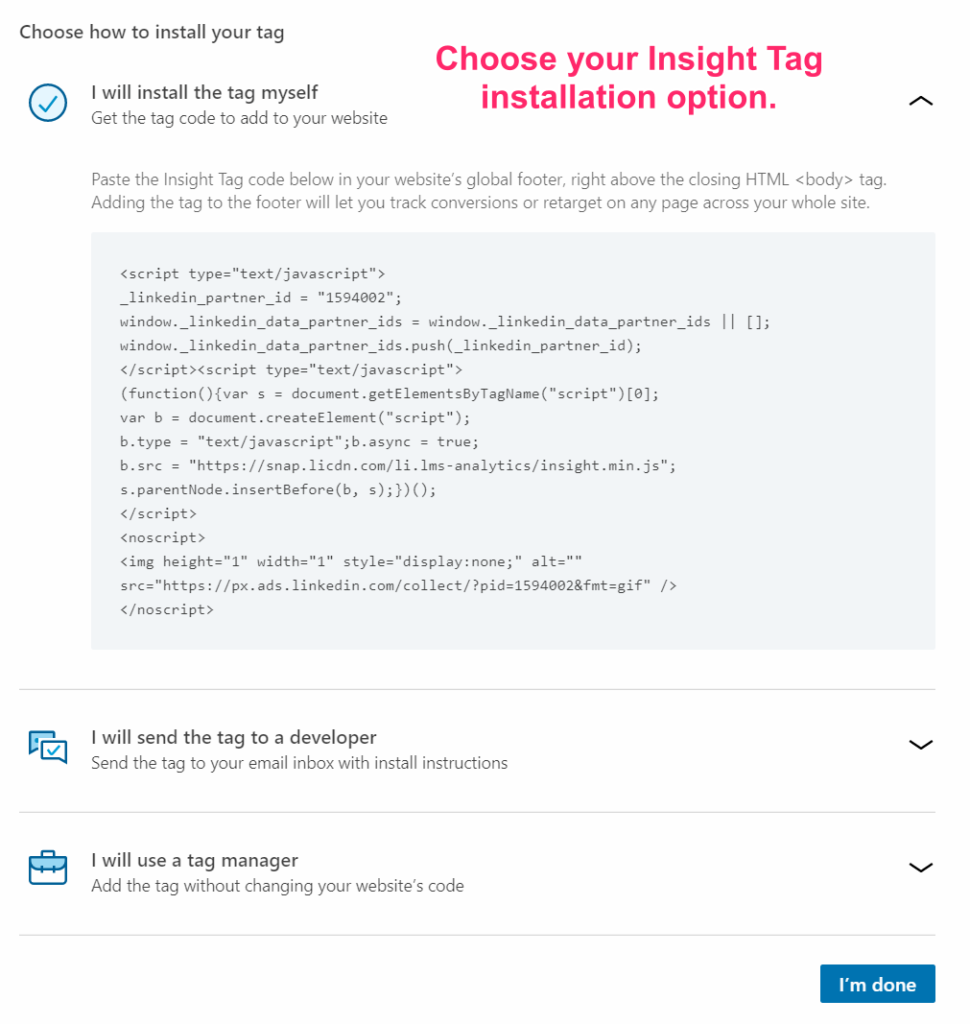
Pro tip: the easiest way to set up the Insight Tag is to put it in the global header of your website — that way even if someone leaves your site quickly, the tag will still load.
Once your Insight Tag is up and running, it’s easy to create specific audiences. Go to your Campaign Manager, set up an audience, and specify the behavior you want to track.
For instance, you might create one audience for everyone who came to your site, and then create specific audiences for people who visited specific landing pages. Once your audiences are set up, you can target them with campaigns tailored specifically for them.
Since LinkedIn uses the tag to track anyone with a LinkedIn profile who visits your site, you can use the Insight Tag to track website demographics. You can gather demographic information like job title, company, and company size for all your visitors who have a LinkedIn profile, giving you a great overall picture of your target customer.
Your Turn
LinkedIn’s targeting capabilities are more powerful than ever. And as we start 2021, it’s the perfect time to take your LinkedIn ad campaigns to the next level.
Revisit your audience targeting to make sure you’re zeroing in on the right attributes. Use account targeting to get your ads in front of decision-makers at the right companies. And take advantage of website retargeting to make sure your content gets seen again and again.
With the right approach, LinkedIn ads can be a game-changer. Looking for help fine-tuning your LinkedIn strategy? Book a call today to learn more about how we can help your business grow in 2021.
